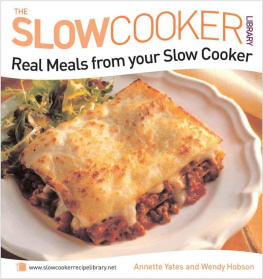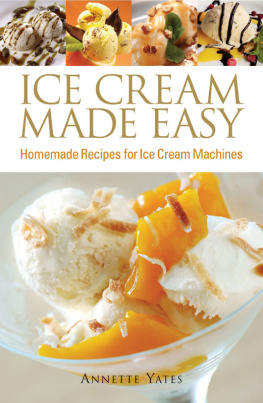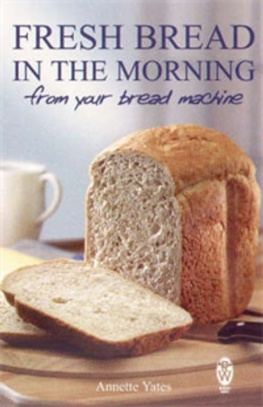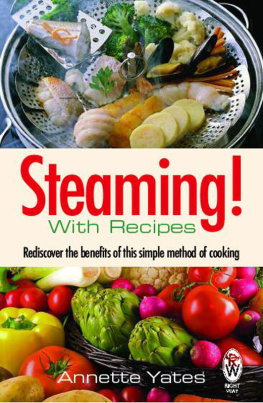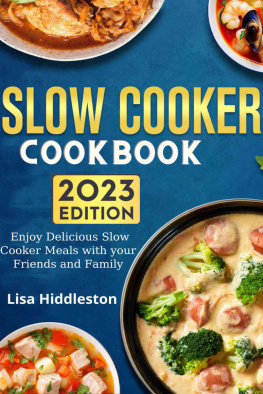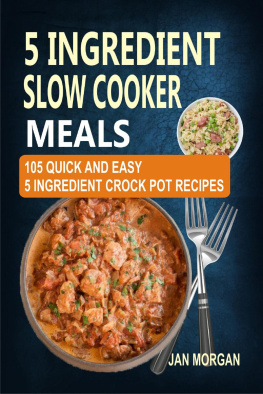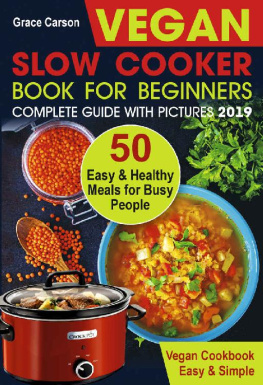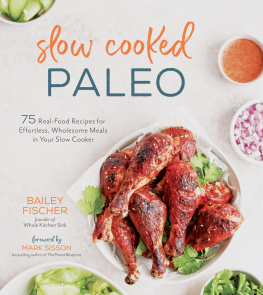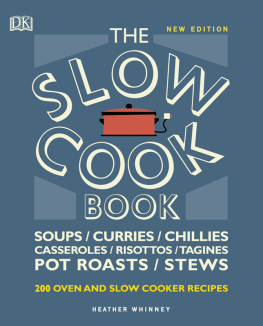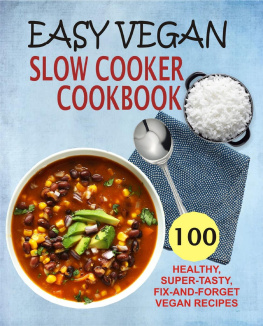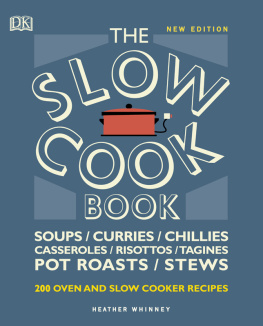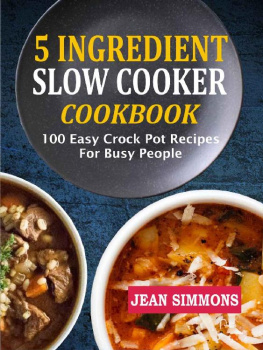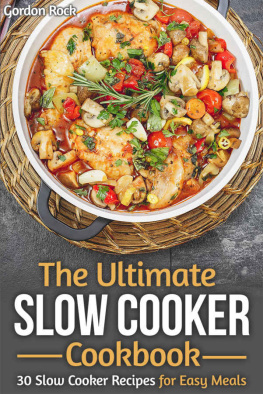
Table of Contents
Introduction
For those of us with no time to spend cooking when we get home from work, slow cookers fit perfectly into our busy lifestyles. Just prepare the ingredients and place them in your slow cooker before leaving home and return to a delicious hot meal. Plus the meals are ready when you are; because of the time range, there is little chance of them spoiling even if you are an hour or two late.
A slow cooker can be used day or night; cook tomorrow's lunch or breakfast overnight, for example. Use the slow cooker while you are out, or while you are at home, and appreciate both the freedom of knowing that a delicious and nutritious meal is cooking itself and the satisfaction of economising on fuel. Some of the recipes have all-day cooking times, but others have shorter cooking times for a mid-day meal or when you simply want to get on with something else while your dinner cooks itself!
Your slow cooker also makes an ideal companion to your freezer as it is simple to use it for larger quantities than usual, then freeze some to use at a later date.
The following recipes provide a selection of interesting and tasty ideas for your slow cooker. But don't stop there: use the recipes as a basis to experiment and develop your own favourite ideas so that your range of delicious meals never stops expanding.
Choosing a Slow Cooker
Always choose a cooker that bears the BEAB safety symbol, which will have a removable pot for ease of use (some older slow cookers had a fixed pot). All slow cookers should have a well-fitting lid, which will be either heat-resistant glass or stoneware. It is not necessarily an advantage to have a glass lid as the condensation will block your view of the cooking food anyway. The main heat settings available are High and Low, which are what you need for the recipes in this book, but many models also now have Medium, and some also have an automatic function and an auto shut-off.
Choose a slow cooker with sufficient capacity for your specific needs and consider whether you will use it for entertaining or for making extra quantities for the freezer. If you regularly cook for one, then a smaller capacity will be fine, but if you cook for four or more, own a freezer or entertain on a regular basis, look for a 3 litre/51/4 pt capacity. A cooker with a wide bowl will be easier to use for ingredients such as (bell) peppers, fish or whole fruit.
Advantages of Slow Cooking
There are many advantages to slow cooking, especially for those who have better things to do than slave over a hot stove! Saving time may be top of your list of advantages, or perhaps the flexibility to cook when you want to and have a hot meal ready whenever you want to eat, but there are plenty of other positive features of slow cooking.
Slow cookers are superb for preparing soups, stocks, casseroles and stews. Flavours blend and develop to produce concentrated, rich and tasty results as all the flavours are sealed in the pot. The slow cooking method tenderises even the toughest cuts of meat and prevents shrinkage of joints.
You are not only saving time and effort but there are also considerable fuel economies with this cooking method. Fuel savings alone can be as much as 80 per cent on normal cooking times. The efficient built-in insulation means only the food inside the slow cooker heats up, not the whole kitchen.
The gentle heat results in less evaporation of liquids so there is little chance of food drying out. The steam condenses on the lid and returns to the pot. In doing so it forms a seal that retains heat and flavour, which avoids steaming up the kitchen and filling it with cooking smells, losing valuable nutrients, and having to top up the steaming water for puddings! This makes the slow cooker ideal for cooking light sponges and steaming smooth pts.
Foods cooked in the slow cooker remain attractively whole a distinct advantage when cooking fruit, fish and other ingredients. There is no need to turn or stir the food as it is not likely to overcook, boil over or stick and there are no hot spots to cause burning.
Once cooking is complete, food can safely be kept on the low setting for several hours without spoiling making it perfect for families who do not all want to eat their meal at the same time.
Preparation and Cooking
Always follow the manufacturer's instructions carefully when connecting the slow cooker to the power supply. The appliance must be earthed. As different models will vary slightly, always check your instruction booklet for the usage instructions of your particular cooker. These basic rules are appropriate to all types.
Preparing food
- Always ensure that frozen ingredients are properly thawed at room temperature before cooking.
- Vegetables take longer to cook than meat as they normally cook at higher temperatures. They should therefore be thinly sliced or diced into 5 mm/ in pieces and placed near the bottom of the slow cooker (the hottest point), covered in the cooking liquid. If you are browning the meat for a recipe, saut the vegetables for a few minutes at the same time. Completely thaw frozen vegetables, then add them during the final hour of cooking.
- Use quick-cooking varieties of pasta or rice and add to the dish for the last 30 minutes of cooking. Soften macaroni and lasagne in boiling water for a few minutes before cooking and make sure they are immersed in liquid. Extra liquid is needed when using raw rice: use 150 ml/ pt/2/3 cup for 100 g/4 oz/ cup of rice. No additional liquid is required when slow cooking cooked rice.
- If using dried beans, soak them overnight in cold water, then bring to the boil in fresh water and boil rapidly for 15 minutes before draining and using in the recipe. This will destroy any natural toxins found in the beans.
- Use seasoning and flavouring ingredients sparingly as most of their flavour is retained during cooking. If in doubt, season lightly, then adjust the seasoning of the finished dish.
Using your slow cooker
- Preheat the slow cooker if necessary, with the lid on. You can assemble, prepare and brown the ingredients while the slow cooker is heating.
- Browning ingredients before placing them in the slow cooker can improve the appearance of the finished dish. Fry prepared meat in a little oil in a frying pan until browned, then add the prepared vegetables and fry until softened and starting to brown.
- If you are using thickening agents, such as flour or cornflour (cornstarch), toss the pieces of meat in the flour before adding them to the frying pan, or stir them into the browning ingredients and stir until browned. If you have not added a thickening agent at the start of cooking, mix the flour or cornflour with a little cold water and stir it into the ingredients for the final 1-1 hours of cooking.
- Transfer the ingredients to the slow cooker using a slotted spoon so that they come to within 1-2 cm/- in of the top of the earthenware pot. Stir in any seasonings.
- Never leave uncooked food in the slow cooker to be switched on later or store a removable slow cooker pot in the fridge. If necessary, store prepared ingredients in a separate container in the fridge.
- Always mix ingredients together well to prevent foods from sticking together.
- Replace the lid and select the recommended heat setting. Where recipes recommend cooking on High for 20-30 minutes before turning to Low, you can use the Auto setting instead, if available.
Next page
